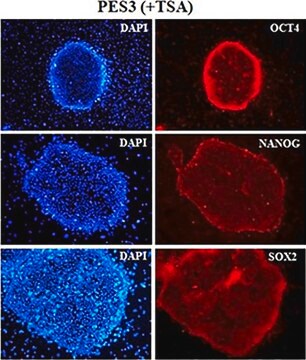MABD76
Anti-Oct-4 Antibody, clone 9B7
clone 9B7, from mouse
Sinónimos:
POU domain, class 5, transcription factor 1, Octamer-binding protein 3, Oct-3, Octamer-binding protein 4, Oct-4, Octamer-binding transcription factor 3, OTF-3
About This Item
Productos recomendados
biological source
mouse
Quality Level
antibody form
purified immunoglobulin
antibody product type
primary antibodies
clone
9B7, monoclonal
species reactivity
mouse
species reactivity (predicted by homology)
human (immunogen homology)
technique(s)
immunofluorescence: suitable
immunohistochemistry: suitable
western blot: suitable
isotype
IgG1κ
NCBI accession no.
UniProt accession no.
shipped in
wet ice
target post-translational modification
unmodified
Gene Information
human ... POU5F1(5460)
General description
Immunogen
Application
Immunocytochemistry Analysis: A previous lot was used by an independent laboratory in COS7 cells.
Stem Cell Research
Transcription Factors
Quality
Western Blot Analysis: 0.5 µg/mL of this antibody detected Oct-4 in 10 µg of mouse embryonic stem cell lysate.
Target description
Physical form
Storage and Stability
Analysis Note
Mouse embryonic stem cell lysate
Disclaimer
¿No encuentra el producto adecuado?
Pruebe nuestro Herramienta de selección de productos.
Optional
Storage Class
12 - Non Combustible Liquids
wgk_germany
WGK 1
flash_point_f
Not applicable
flash_point_c
Not applicable
Certificados de análisis (COA)
Busque Certificados de análisis (COA) introduciendo el número de lote del producto. Los números de lote se encuentran en la etiqueta del producto después de las palabras «Lot» o «Batch»
¿Ya tiene este producto?
Encuentre la documentación para los productos que ha comprado recientemente en la Biblioteca de documentos.
Nuestro equipo de científicos tiene experiencia en todas las áreas de investigación: Ciencias de la vida, Ciencia de los materiales, Síntesis química, Cromatografía, Analítica y muchas otras.
Póngase en contacto con el Servicio técnico